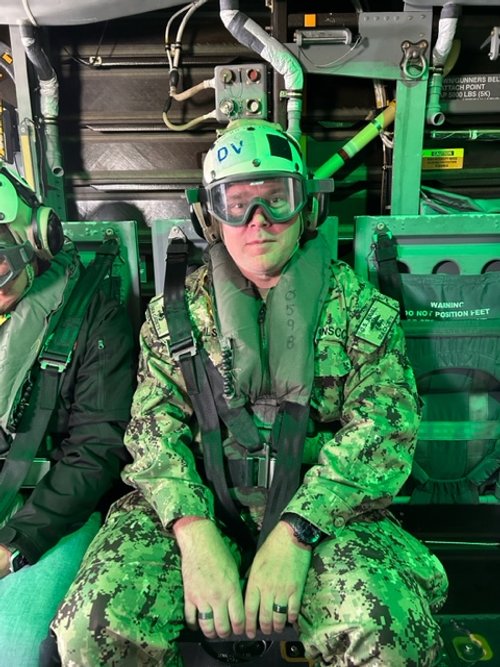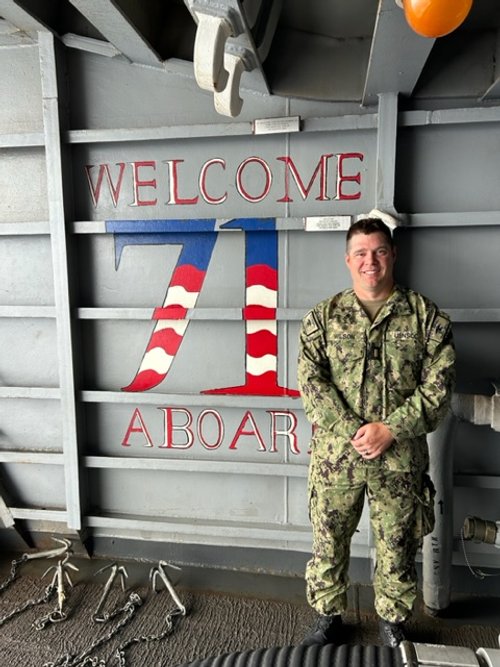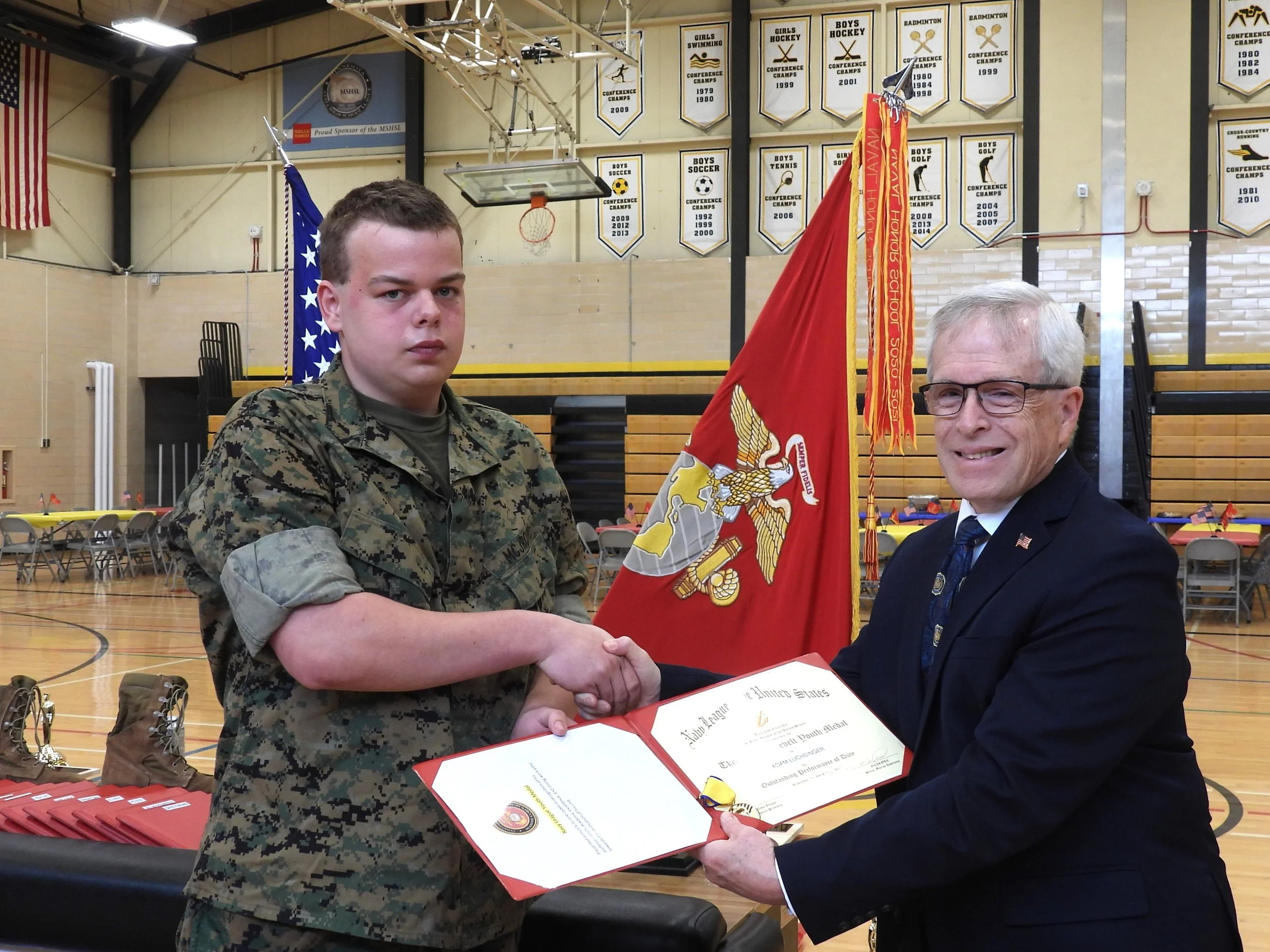US Navy – Distinguished Visitor Program
By Ensign Shawn Wilson, Commanding Officer, Twin Cities Squadron Sea Cadets
Who doesn’t want to be Maverick in Top Gun? For most of us, this is a dream we can realize only through Hollywood movies and video games. The idea of a setting foot on an underway navy warship is equally unrealistic, so we settle for spending a few bucks to visit decommissioned museum pieces.
But is that the whole story? The answer is no. The US Navy – Distinguished Visitor (DV) Program exists to provide muggles (civilians) a once in lifetime opportunity and glimpse into the world of naval aviation, up close and personal. The program is designed for leaders in local, civic, education and business communities to foster awareness and understanding of the role of naval aviation in meeting the nation’s needs.
Ensign Wilson rides a CMV-22B Osprey to join the USS Theodore Roosevelt at sea.
DV’s embark from one of several naval stations (Norfolk, Jacksonville, San Diego, Pearl Harbor) to an aircraft carrier conducting training operations at sea. I was fortunate enough to be nominated by the NLUS-Minnesota Council and selected to participate in this program. Here is my Top Gun story.
I arrived at Naval Air Station – North Island, the birthplace of naval aviation and home to the Pacific Command Naval Air Force. Moored at the piers were gigantic hulks bearing the hull numbers CVN 72 and CVN 70, the USS Abraham Lincoln and Carl Vinson respectively. My intended destination, USS Theodore Roosevelt (CVN 71) was already underway and operating some 150-175 nautical miles off the coast in the North Pacific Ocean. Following a brief tour, photo ops and the obligatory safety briefing it was time to fly.
A group of 12 DV’s, mostly academics, a sea cadet Commanding Officer and a rock n roll drummer boarded a CMV-22B Osprey. Seriously, she played the drums on the Top Gun soundtrack! After an exhilarating 1.5 hour flight cruising at 6,000 ft with the rear cargo hatch open, exposing the blue waters below, we arrived. I successfully completed my first tiltrotor landing as sea! And I have the patch to prove it!
Once aboard, the organized chaos of the flight deck hits you as fast as the rotor wash and smell of jet fuel. The array of colors, like a bag of skittles, adds to the sensory overload. The airboss and miniboss extended a welcome aboard wave from tower control. So focused on each step to avoid tripping on the no skid surface on the weather deck, I hardly appreciated the MH-60 Seahawks, E-2 Hawkeyes and F-18 Hornets and Super hornets preparing for daily flight operations.
After a quick introductory meeting with the Skipper and XO, the DV’s were ushered below decks to get prepared for the flight deck. I made a mental note, the CO’s foreword cabin was way nicer than anything I had seen on those old WW2 ships. Preparing for the flight deck, Kenny Loggins Danger Zone began to play in my head. This was it, I got to don a white float coat with DV on the back and its array of salt water activated life saving devices in the event I fell (or was blown) overboard. Then the white “cranial” helmet with integrated hearing protection and googles. At this point all efforts to communicate required hand signals. Up two decks and onto a catwalk. This was the first time I realized the ship was moving, and it was fast. Looking down through the holes, 70 feet below the water rushed by and created gentle swells as it rolled off the hull. What a magnificent shade of blue.
Rounding a corner past the island our guide, a freshly minted Ens., welcomed us to the flight deck by walking us directly through the jet wash from an F-18. The heat and smell alone were reminders to avoid that in the future – a safety lesson in real time. We approached the Shooter (yellow jersey) or Flight Deck Officer and toe up to the foul line of catapult number 2. The symphony begins. The blast shield raises behind an F-18 Super Hornet. Green jerseys move in to secure the aircraft to the shuttle and restraining bar. White jersey’s (Safety Officers) give the thumbs up when the flaps are tested. The shooter gives the pilot the signal to throttle up, in this case full combat thrust (aka afterburners). The pilot gives a final salute and grabs the cockpit, or “oh shit”, handle. The shooter drops to one knee, final checks and a tap of the flight deck pointing downrange. The catapult control station releases the steam operated catapult and in 2 seconds that F-18 is travelling 180+ knots launching off the bow. No time to contemplate what I just witnessed. The deafening roar, shaking of the deck and heat from the afterburners roaring past me, a mere 30 feet away. Time to move! We toe up to the opposite foul line, and another F-18 launches barely a minute later. Rinse and repeat, the symphony continued until the mission set was launched.
About 75 minutes later it was time to recover those aircraft. They move into approach, 2 miles out. Damage control teams (red jerseys) stand at the ready to jump into action in the event of a catastrophe. The goal is not to hit a wire, but the third wire every time. And to do it while travelling 150 knots. To low you risk hitting the fantail, to high and you miss the wires. The Landing Signal Officer (LSO) guides them in with the Fresnel lens optical landing system, aka the meatball. The pilot gracefully passes over the stern and with a violent thud, and sudden rush of power drags the arresting gear wire some 350 feet, coming to a rest a precariously short distance from the edge of the deck at the end of catapults 3 and 4. The arresting gear quickly recoils, the green jerseys guide the F-18 away from the landing zone. A minute later, the next F-18 completes the landing, this time catching the second wire. Each pilot is graded on every approach and landing, and so the friendly competition between these Top Guns begins.
Admittedly, nothing can beat watching flight operations on the weather deck. That evening, we mingled with the officers in the wardroom, learning their stories. Up to the flag bridge and vultures’ row for night flight operations. The evening wound down with a walk through the hangar, and getting oriented to the various decks, and differences between enlisted and officer country.
Fortunately, we were treated to officers’ quarters for berthing, but even then, it was directly below the number 2 catapult. It was not the high seas that keep me up most of the night, but the repetitive sound of the launch system and sailors on night watch passing through passageways talking shop and life.
Up at 0600 and morning chow with the enlisted. No complaints here, the chow was fantastic and sailors eager to talk to someone other than ships company. For the rest of the morning, we toured the various departments and shops, learning about what it took to keep this floating city alive and functioning at peak performance. Of course, military secrets and all we were not allowed in some areas and photography was restricted or prohibited. The ordinance magazines housing sidewinder missiles, bunker busters and an array of highly classified things that go boom!
Afternoon chow was a real treat, the Chief Mess. Arguably the most sacred space on the ship. The Chief’s are widely considered the backbone of ship, and they work hard and long hours. But get them in a relaxed atmosphere and you can see they are a special breed with a personality that is very different from the enlisted ranks and officers.
To round out our tours, we got to visit the Navigation Bridge where the responsibility levels seem to rachet up a notch, and the tension level was higher. The constant chorus of bearing, range, and time marks filled the air. Everyone had a job, and they did it with a no-nonsense precision. The ships captain sat calmly overseeing the operation from what can only be described as a throne overlooking the deck.
To complete the Top Gun experience, nothing can beat a trip through the Air Department. Home Air Wing Groups are assigned to the ship. We had the Checkmates, Jokers, Titans and my personal favorite the Black Nights. Each with cadre of support staff combing through flight data, maintenance reports and landing evaluations. Then though a highly decorated hatch, often adorned with some version of KEEP OUT, was the pilots ready room. A floating pad adorned with big screen TV’s, surround sound, chairs that resemble cockpits, mood lighting and any number of caricatures depicting the squadrons colors and logo. Aviators comparing notes on landings, and the blue board chalked full of call signs and otherwise uninterpretable data on upcoming flight plans and mission sets. Be careful to avoid the heavy bolt hanging precariously at head-level knocking height over one pilot’s chair – the last in the squadron to miss a wire. Merely touching it is sure to bring bad luck. Being the proud owner is not good thing. Moving through the squadron spaces, we visit the equipment rooms where technicians tend to flight suits and helmets with head up display systems worth more than some homes on the mainland. I deferred the opportunity to suit up, I don’t need the memory of dropping Mavericks helmet on the deck. I would be awarded the bolt for sure! Or the washer!
Our visit concluded with a return trip aboard another Osprey, earning my patch for my first tiltrotor takeoff at sea. It wasn’t the “cat shot” of my Top Gun dreams, but it sure checked off a bucket list item or maybe ten items.
A special thanks to the sailors and airmen of the USS Theodore Roosevelt for giving this muggle a view into your world, and the sacrifices you make everyday to protect the freedom we all enjoy. I am honored to say I have embarked with the best – the US Navy! Hooyah!
Ensign Shawn Wilson is the Commanding Officer of Twin Cities Squadron Sea Cadets located in Arden Hills, Minnesota. Twin Cities Squadron is the largest of three Sea Cadet units in Minnesota and has both League Cadets (Ages 10-12) and Sea Cadets (Ages 13-18). The Twin Cities Squadron is part of the U.S. Naval Sea Cadet Corps







